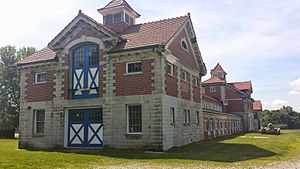Barberton, Ohio facts for kids
Quick facts for kids
Barberton, Ohio
|
|
|---|---|
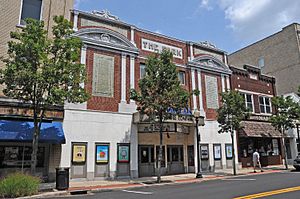
Buildings in downtown Barberton, 2008
|
|
| Nickname(s):
The Magic City
|
|
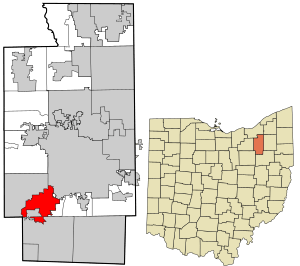
Location in Summit County and the state of Ohio.
|
|
| Country | United States |
| State | Ohio |
| County | Summit |
| Area | |
| • Total | 9.24 sq mi (23.93 km2) |
| • Land | 9.02 sq mi (23.35 km2) |
| • Water | 0.22 sq mi (0.57 km2) |
| Elevation | 958 ft (292 m) |
| Population
(2020)
|
|
| • Total | 25,191 |
| • Estimate
(2023)
|
24,563 |
| • Density | 2,793.72/sq mi (1,078.70/km2) |
| Time zone | UTC-5 (Eastern (EST)) |
| • Summer (DST) | UTC-4 (EDT) |
| ZIP Code |
44203
|
| Area codes | 330, 234 |
| FIPS code | 39-03828 |
| GNIS feature ID | 1086994 |
Barberton is a city in Ohio, USA. It's located in Summit County, just southwest of Akron. In 2020, about 25,000 people lived there. It's like a smaller town connected to the bigger city of Akron.
Contents
History of Barberton
Barberton was started in 1891 by a businessman named O.C. Barber. He had a big idea to build a city focused on factories, growth, and community. In 1894, he moved his huge match-making company, the Diamond Match Company, to Barberton. He made an amazing 250 million matches every day!
He built factories, homes, and a busy downtown area near the Tuscarawas River and the Ohio & Erie Canal. Right in the middle of the new city, he created Lake Anna, named after his daughter, Anna Laura.
Why Barberton is Called the "Magic City"
Barberton quickly became known as the "Magic City." This was because it grew so fast in its early years. Many people from other countries came to Barberton for factory jobs. These jobs helped them start new lives.
In 1891, Barberton was just a few farms with about 1,800 people. By 1893, a reporter from the Akron Beacon Journal newspaper visited and said it had grown so quickly it seemed like magic!
The Anna-Dean Farm Project
In 1908, O.C. Barber started building a huge experimental farm and estate called Anna–Dean Farm. It was on a high hill on the east side of town. The farm included his 52-room mansion, finished in 1909. It also had beautiful gardens and many barns and buildings, all built in a fancy French style.
Barber built 35 buildings for the Anna-Dean Farm, covering 3,500 acres. He believed farming could be as efficient as a factory. He wanted the farm to become a college for agriculture, but he didn't finish setting up the funding before he passed away. He left the farm to Western Reserve University (now Case Western Reserve University). The university later sold most of the land.
Today, the Barberton Historical Society owns five of the main farm buildings. These buildings are made of red brick with white concrete and have blue trim and red tile roofs. The most important building left is Barn No. 1, which used to be the Dairy Barn. It was fixed up in 1985 and is now the main office for a plant company. This building has tall, castle-like silos that you can see from many parts of the city.
Barberton's Schools and Community Spirit
The sports teams at Barberton High School are called "The Magics," honoring the city's nickname. Their school colors are purple and white, and "purple pride" shows how much local people support the school. The schools in Barberton have also improved their academic results since the 1980s.
Barberton's Economic Changes
In the 1980s, Barberton faced tough times. Many factories closed, and people lost jobs. This was similar to other industrial cities in the American Midwest. The city lost a lot of its businesses, and stores became empty.
To help the city, local business leaders and government officials created the Barberton Community Development Corporation (BCDC) in 1985. This group has helped create over 2,000 jobs and brought in more than $100 million for business projects. They have also helped build three small industrial parks and 25 new construction projects.
The Barberton Community Foundation also helped build a new Barberton High School. It was built on land that used to be a swamp in the northwest part of the city.
Geography of Barberton
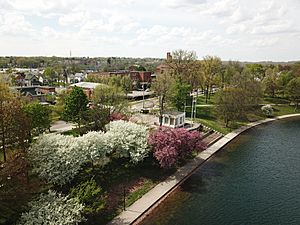
Barberton covers about 9.26 square miles. Most of this area, about 9.04 square miles, is land, and a small part, about 0.22 square miles, is water.
Lake Anna is a natural spring lake that is 10 acres big. It's located right in the center of Barberton. The lake is part of a 21-acre park named after it. As you learned, Lake Anna was named after O. C. Barber's daughter, Anna Laura Barber.
Population Information
| Historical population | |||
|---|---|---|---|
| Census | Pop. | %± | |
| 1900 | 4,354 | — | |
| 1910 | 9,410 | 116.1% | |
| 1920 | 18,811 | 99.9% | |
| 1930 | 23,934 | 27.2% | |
| 1940 | 24,028 | 0.4% | |
| 1950 | 27,820 | 15.8% | |
| 1960 | 33,805 | 21.5% | |
| 1970 | 33,052 | −2.2% | |
| 1980 | 29,732 | −10.0% | |
| 1990 | 27,623 | −7.1% | |
| 2000 | 27,899 | 1.0% | |
| 2010 | 26,550 | −4.8% | |
| 2020 | 25,191 | −5.1% | |
| 2023 (est.) | 24,563 | −7.5% | |
| Sources: | |||
Barberton's People in 2010
In 2010, there were 26,550 people living in Barberton. These people lived in 11,054 homes. About 30% of these homes had children under 18 living there.
Most of the people in Barberton were White (90.8%). About 5.9% were African American, and smaller percentages were Native American, Asian, or from other backgrounds. About 1.4% of the population was Hispanic or Latino.
The average age in Barberton was about 39.8 years old. About 23.5% of residents were under 18, and 16.5% were 65 or older.
Culture and Food
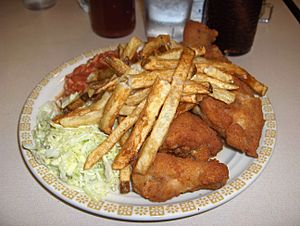
Barberton is famous for its unique style of Barberton chicken, which is a type of fried chicken. This special chicken dish is served in several restaurants in the area, many of which are owned by people of Serbian heritage. Because of this popular dish, some people call Barberton the "Chicken Capital of the World" or the "Fried Chicken Capital of America."
Education in Barberton
Children in Barberton attend public schools run by the Barberton City School District. The schools serving the city are:
- Barberton Primary School – for grades K-2
- Barberton Intermediate School – for grades 3-5
- Barberton Middle School – for grades 6-8
- Barberton High School – for grades 9-12
News and Media
For news, people in Barberton can read daily newspapers from nearby cities, like the Akron Beacon Journal from Akron and The Plain Dealer from Cleveland. There's also a local weekly newspaper called the Barberton Gazette, which started in August 2023. Before that, the city had a weekly newspaper called the Barberton Herald, which stopped printing in December 2022.
Transportation
Barberton station was once a train station on the Erie Railroad line. It opened in 1890. Passenger train service stopped on August 1, 1965.
Famous People from Barberton
Many notable people have come from Barberton, including:
- John Cominsky, a professional football player
- Glenn Davis, an Olympic gold medalist runner and professional football player
- Derrick Dukes, a professional wrestler
- David M. Kelley, who helped start the design company IDEO
- Scot Loeffler, a college football coach
- John Mackovic, a football coach for both professional and college teams
- Josh McDaniels, a football coach
- George Morgan, a country music singer
- Hal Naragon, a professional baseball player
- Alvin Robertson, a professional basketball player
- Bo Schembechler, a college football coach
- Lynn St. John, a sports director for The Ohio State University
- Betty Sutton, a politician
- Jeff Tabaka, a professional baseball player
- Lynne M. Tracy, the United States Ambassador to Russia
- Joe Williams, a professional football player
- Howard E. Woodford, a recipient of the Medal of Honor
See also
 In Spanish: Barberton (Ohio) para niños
In Spanish: Barberton (Ohio) para niños


